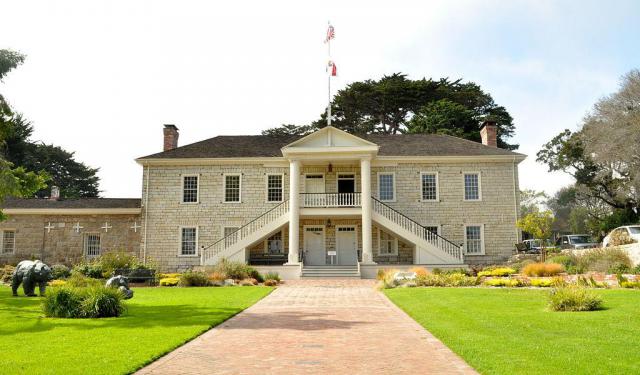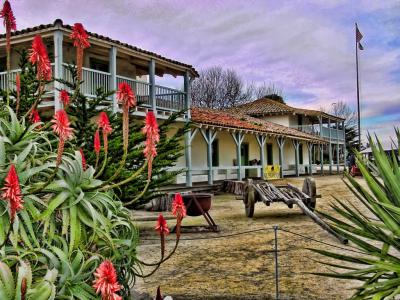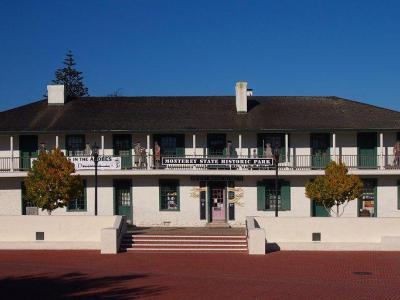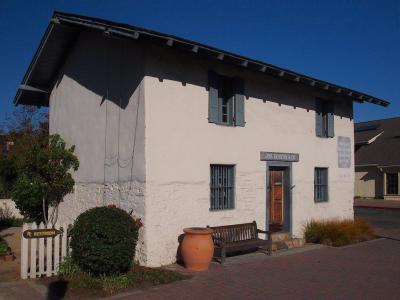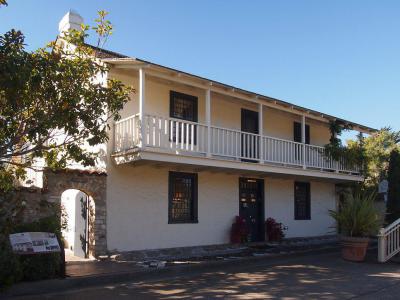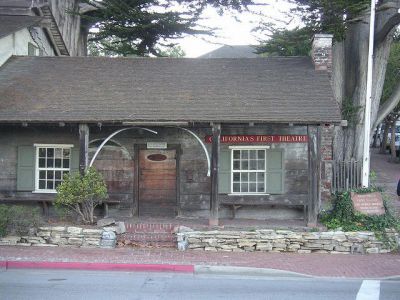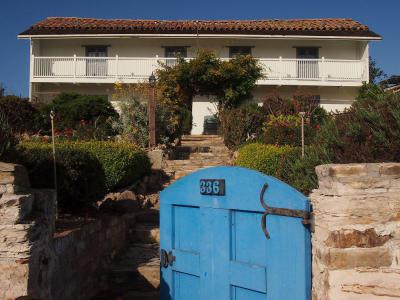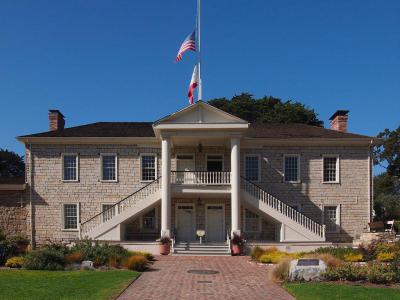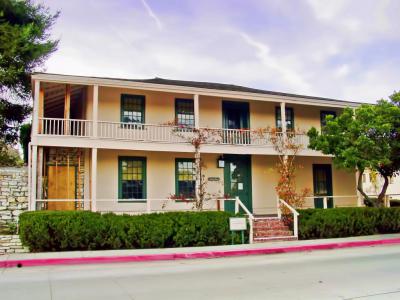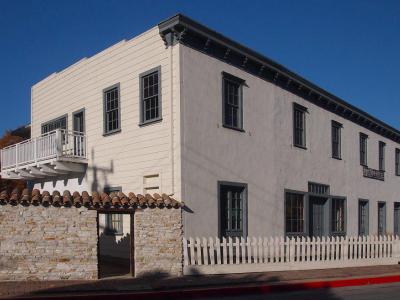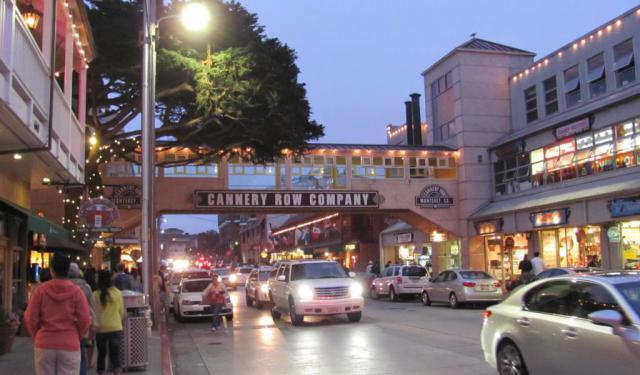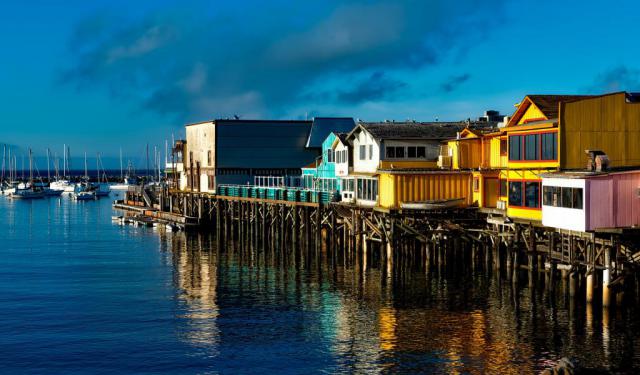Monterey State Historic Park Walk (Self Guided), Monterey
Monterey State Historic Park is a National Landmark and a part of the Monterey Old Town Historic District. Found on the grounds here are a group of significant old-time houses that once made up California's earliest capital and were the site of the state's first constitutional convention. Today these buildings retain their rich heritage, preserving an important part of Californian as well as Spanish, Mexican, and American history.
Among the buildings in question are California's First Theatre and Monterey's Old Customhouse – where the American flag was first raised over California, as a new part of the United States, in 1846.
Also noteworthy are: the Larkin House – California's first two-story brick house; Colton Hall – the City Hall of Monterey; Old Whaling Station, built in 1847; the Stevenson House – named so in honor of the Scottish novelist Robert Louis Stevenson who stayed here whilst recovering his health en route across the United States in 1879; Casa del Oro (the "House of Gold"); Casa Soberanes, which received its nickname - “The House of the Blue Gate” - from the blue gate at its garden entrance on Pacific Street; and many others.
If you're keen to explore the historical facets of America's West and to appreciate the cultural diversity that guided California's transition from a remote Spanish outpost to U.S. Statehood, take your time and embark on this self-guided walking tour. A great way to complete your discovery of Monterey!
Among the buildings in question are California's First Theatre and Monterey's Old Customhouse – where the American flag was first raised over California, as a new part of the United States, in 1846.
Also noteworthy are: the Larkin House – California's first two-story brick house; Colton Hall – the City Hall of Monterey; Old Whaling Station, built in 1847; the Stevenson House – named so in honor of the Scottish novelist Robert Louis Stevenson who stayed here whilst recovering his health en route across the United States in 1879; Casa del Oro (the "House of Gold"); Casa Soberanes, which received its nickname - “The House of the Blue Gate” - from the blue gate at its garden entrance on Pacific Street; and many others.
If you're keen to explore the historical facets of America's West and to appreciate the cultural diversity that guided California's transition from a remote Spanish outpost to U.S. Statehood, take your time and embark on this self-guided walking tour. A great way to complete your discovery of Monterey!
How it works: Download the app "GPSmyCity: Walks in 1K+ Cities" from Apple App Store or Google Play Store to your mobile phone or tablet. The app turns your mobile device into a personal tour guide and its built-in GPS navigation functions guide you from one tour stop to next. The app works offline, so no data plan is needed when traveling abroad.
Monterey State Historic Park Walk Map
Guide Name: Monterey State Historic Park Walk
Guide Location: USA » Monterey (See other walking tours in Monterey)
Guide Type: Self-guided Walking Tour (Sightseeing)
# of Attractions: 9
Tour Duration: 1 Hour(s)
Travel Distance: 1.9 Km or 1.2 Miles
Author: nicole
Sight(s) Featured in This Guide:
Guide Location: USA » Monterey (See other walking tours in Monterey)
Guide Type: Self-guided Walking Tour (Sightseeing)
# of Attractions: 9
Tour Duration: 1 Hour(s)
Travel Distance: 1.9 Km or 1.2 Miles
Author: nicole
Sight(s) Featured in This Guide:
- Old Customhouse
- Pacific House Museum and Memory Garden
- Casa del Oro
- Old Whaling Station and First Brick House
- California's First Theatre
- Casa Soberanes
- Colton Hall Museum
- Larkin House
- Stevenson House
1) Old Customhouse
The Old Customhouse, located in Monterey County, California, is an adobe building constructed in the Spanish Colonial style around 1827 during the period when Mexico governed the region. It holds the distinction of being California's inaugural California Historical Landmark. This designation commemorates the site where U.S. Commodore John Drake Sloat raised the American flag in 1846, officially incorporating California into the United States.
Following Mexico's victory over Spain and its subsequent independence in 1821, Monterey remained within the Mexican Territory of Alta California for nearly 25 years. To manage the collection of customs duties (taxes) at the port of Monterey Bay, the Mexican government erected the Customhouse, making it the oldest surviving government building in California today.
The Monterey Customhouse garnered significant attention from the Native Sons of the Golden West, who were determined to preserve it from fading into obscurity. Although the property was owned by the United States Government, the Native Sons secured a lease for the buildings and grounds. They embarked on a restoration effort in the early 1900s. Subsequently, the lease was transferred to a State Commission, established by legislative action in 1901, which also allocated funds for further restoration work on the structure.
On June 1, 1932, the Customhouse was officially designated as the first California Historical Landmark. Later, in 1960, it received the status of a National Historic Landmark. It is now an integral part of the larger Monterey State Historic Park, which itself holds National Historic Landmark District status, along with the nearby Larkin House.
Following Mexico's victory over Spain and its subsequent independence in 1821, Monterey remained within the Mexican Territory of Alta California for nearly 25 years. To manage the collection of customs duties (taxes) at the port of Monterey Bay, the Mexican government erected the Customhouse, making it the oldest surviving government building in California today.
The Monterey Customhouse garnered significant attention from the Native Sons of the Golden West, who were determined to preserve it from fading into obscurity. Although the property was owned by the United States Government, the Native Sons secured a lease for the buildings and grounds. They embarked on a restoration effort in the early 1900s. Subsequently, the lease was transferred to a State Commission, established by legislative action in 1901, which also allocated funds for further restoration work on the structure.
On June 1, 1932, the Customhouse was officially designated as the first California Historical Landmark. Later, in 1960, it received the status of a National Historic Landmark. It is now an integral part of the larger Monterey State Historic Park, which itself holds National Historic Landmark District status, along with the nearby Larkin House.
2) Pacific House Museum and Memory Garden
This property in Monterey consists of a two-story adobe building that David Wright, a Scottish-born architect, constructed in 1847. Some of the functions this building has served include being a home for seafarers, a courthouse, and a law office. The state has owned this property since 1954.
One of the most unusual things about this building is that it has a well enclosed within the walls. As a result, over the years, the water has been free of contamination. Outside the building, a walled garden is the site of the city's annual Merienda celebration.
A costume exhibit that Monterey History and Art Association maintains is one of the most popular highlights here. In addition, you can check out Native American artifacts from the Holman Collection that offer insights into how these local, ancient cultures lived. Another benefit of this site is the California Museum of History housed on the property.
One of the most unusual things about this building is that it has a well enclosed within the walls. As a result, over the years, the water has been free of contamination. Outside the building, a walled garden is the site of the city's annual Merienda celebration.
A costume exhibit that Monterey History and Art Association maintains is one of the most popular highlights here. In addition, you can check out Native American artifacts from the Holman Collection that offer insights into how these local, ancient cultures lived. Another benefit of this site is the California Museum of History housed on the property.
3) Casa del Oro
The Joseph Boston Store, often referred to as Casa del Oro (House of Gold), was among the earliest general stores in the Monterey region. Constructed around 1845 using limestone and adobe, this two-story building was the work of Thomas O. Larkin, then the American Consul to Alta California. Around 1849, Joseph Boston took over the building, setting up a shop that sold a diverse range of items, from silverware and pans to walnuts and soap.
A notable feature of this store was Monterey's first safe, introduced by Boston. In the absence of banks, business owners like Boston had to secure their earnings, and his store's safe became a secure spot for miners to store their gold, likely leading to its nickname "Casa del Oro" or "House of Gold." Remarkably, the safe, as well as Boston's original desk, remain in the store to this day.
Monterey's status as a key seaport facilitated international trade, and Boston's store was a hub for this, dealing with various countries and attracting Russian sea captains, among others.
Presently, the store functions under the management of the Historic Garden League, a non-profit organization. It sells items reminiscent of the 1850s, including children’s toys, housewares, and candy, with a mix of replicas and authentic antiques. Adjacent to it is the Picket Fence Garden Store, also run by the League. Sales from these stores contribute to the enhancement of Monterey's historical gardens.
A notable feature of this store was Monterey's first safe, introduced by Boston. In the absence of banks, business owners like Boston had to secure their earnings, and his store's safe became a secure spot for miners to store their gold, likely leading to its nickname "Casa del Oro" or "House of Gold." Remarkably, the safe, as well as Boston's original desk, remain in the store to this day.
Monterey's status as a key seaport facilitated international trade, and Boston's store was a hub for this, dealing with various countries and attracting Russian sea captains, among others.
Presently, the store functions under the management of the Historic Garden League, a non-profit organization. It sells items reminiscent of the 1850s, including children’s toys, housewares, and candy, with a mix of replicas and authentic antiques. Adjacent to it is the Picket Fence Garden Store, also run by the League. Sales from these stores contribute to the enhancement of Monterey's historical gardens.
4) Old Whaling Station and First Brick House
The Old Whaling Station and First Brick House are within the confines of Monterey State Historic Park. The location inside this landmark makes it easier to appreciate the beautiful surroundings. Both buildings are monuments to Monterey's past and perfect ways to learn more about the area's background.
The Old Whaling Station building goes back to 1847 when it was originally used as a private home. The Old Monterey Whaling Company acquired this building in 1855 for employee housing and its headquarters. Visitors will enjoy seeing the front walkway, which was constructed of whale vertebrae.
Another treasure next to the Old Whaling Station dating to 1847 is the First Brick House, which Gallant Dickenson constructed. It was the first structure built by bricks in California. However, the original owner left to prospect for gold, leaving the home's interior unfinished. Although part of the state historic park today, the building has been used as a restaurant in the past.
The Old Whaling Station building goes back to 1847 when it was originally used as a private home. The Old Monterey Whaling Company acquired this building in 1855 for employee housing and its headquarters. Visitors will enjoy seeing the front walkway, which was constructed of whale vertebrae.
Another treasure next to the Old Whaling Station dating to 1847 is the First Brick House, which Gallant Dickenson constructed. It was the first structure built by bricks in California. However, the original owner left to prospect for gold, leaving the home's interior unfinished. Although part of the state historic park today, the building has been used as a restaurant in the past.
5) California's First Theatre
The First Theater, also known as California's earliest theater, is a notable structure made of adobe and wood located in Monterey, California. It was constructed between 1846 and 1847 by Jack Swan, an English sailor and early settler. Initially, it served as a lodging and tavern for sailors. This venue hosted California's first theater shows. On January 31, 1934, it was recognized as a California Historical Landmark.
Jack Swan bought land in Monterey around 1845-47, before the American takeover in July 1846. The First Theater was built on what is now the corner of Pacific and Scott Streets. Its construction happened in two phases: initially, a small wooden part was built around 1845 from shipwreck lumber, serving as a boarding house and tavern for sailors. This section had four two-room units, each with its own fireplace and doors on both sides. The rooms had adjustable partitions.
Swan then added a larger adobe section in late 1847, intended as a sailor's boarding house but later transformed into a theater. This happened when four soldiers from Santa Barbara and three local comedians organized a minstrel show. The theater was 75 feet long and 12 feet wide, accommodating 200 people, with a pit and stage. The space had a wooden curtain on hinges that could be moved up and down. Event programs were handwritten, and posters were made using a blacking pot and brush.
Jack Swan bought land in Monterey around 1845-47, before the American takeover in July 1846. The First Theater was built on what is now the corner of Pacific and Scott Streets. Its construction happened in two phases: initially, a small wooden part was built around 1845 from shipwreck lumber, serving as a boarding house and tavern for sailors. This section had four two-room units, each with its own fireplace and doors on both sides. The rooms had adjustable partitions.
Swan then added a larger adobe section in late 1847, intended as a sailor's boarding house but later transformed into a theater. This happened when four soldiers from Santa Barbara and three local comedians organized a minstrel show. The theater was 75 feet long and 12 feet wide, accommodating 200 people, with a pit and stage. The space had a wooden curtain on hinges that could be moved up and down. Event programs were handwritten, and posters were made using a blacking pot and brush.
6) Casa Soberanes
In the 1840s, Rafael Estrada constructed Casa Soberanes using sun-dried mud, also known as adobe. This residence has been home to multiple generations of families over the years. From 1860 to 1922, it was inhabited by the Soberanes family. Subsequently, in the 1920s and 30s, the Serranos acquired and meticulously restored the house. Upon entering, visitors will encounter a captivating mix of early New England and China trade furnishings, interwoven with contemporary Mexican folk art.
The residence earned its moniker due to the distinctive blue gated entrance. Throughout the sheltered garden, pathways are adorned with wine bottles, whale bones, and abalone shells.
Presently, Casa Soberanes, along with numerous other significant structures in Old Monterey, is safeguarded and overseen by California State Parks as part of Monterey State Historic Park. While the interiors of many historic adobes can only be accessed with the guidance of a State Park Tour Guide, this website offers you the opportunity to delve into the extensive assortment of artifacts and narratives found within this historically rich home.
The residence earned its moniker due to the distinctive blue gated entrance. Throughout the sheltered garden, pathways are adorned with wine bottles, whale bones, and abalone shells.
Presently, Casa Soberanes, along with numerous other significant structures in Old Monterey, is safeguarded and overseen by California State Parks as part of Monterey State Historic Park. While the interiors of many historic adobes can only be accessed with the guidance of a State Park Tour Guide, this website offers you the opportunity to delve into the extensive assortment of artifacts and narratives found within this historically rich home.
7) Colton Hall Museum
Colton Hall, constructed in the 1840s by Walter Colton, originally arrived in Monterey as a chaplain aboard Commodore Stockton's vessel. He later assumed the role of Monterey's inaugural alcalde (mayor) during the American Period.
Initially, Colton Hall served as both a public school and a venue for government meetings. It gained historical significance as the site of California's inaugural constitutional convention in 1849. At that time, California's military governor convened the convention in Colton Hall, situated in Monterey. Delegates from ten districts gathered in Monterey on September 1 to deliberate and draft California's inaugural constitution. The California Constitution was ratified on October 13, voted upon in the same year's November, and subsequently forwarded to Congress in January 1850. San Jose was designated as the location for the first Legislature, as per the official definition of a State Capital, which is where the Legislature convenes; hence, Monterey never held the title of State Capitol.
In 1903, the Native Sons of the Golden West played a pivotal role in securing legislative funding for necessary repairs to Colton Hall. Over the years, Colton Hall has served various public functions, including housing Monterey's City Hall, a public school, the county courthouse, the sheriff's office, and Monterey's city police headquarters. Presently, some city offices, such as the city Planning Division and Building Safety Division, occupy the main floor, while the second floor functions as a museum. This historic building remains in continuous use and holds a central position in the history of Monterey County.
Initially, Colton Hall served as both a public school and a venue for government meetings. It gained historical significance as the site of California's inaugural constitutional convention in 1849. At that time, California's military governor convened the convention in Colton Hall, situated in Monterey. Delegates from ten districts gathered in Monterey on September 1 to deliberate and draft California's inaugural constitution. The California Constitution was ratified on October 13, voted upon in the same year's November, and subsequently forwarded to Congress in January 1850. San Jose was designated as the location for the first Legislature, as per the official definition of a State Capital, which is where the Legislature convenes; hence, Monterey never held the title of State Capitol.
In 1903, the Native Sons of the Golden West played a pivotal role in securing legislative funding for necessary repairs to Colton Hall. Over the years, Colton Hall has served various public functions, including housing Monterey's City Hall, a public school, the county courthouse, the sheriff's office, and Monterey's city police headquarters. Presently, some city offices, such as the city Planning Division and Building Safety Division, occupy the main floor, while the second floor functions as a museum. This historic building remains in continuous use and holds a central position in the history of Monterey County.
8) Larkin House
The Larkin House, constructed in 1835 by Thomas O. Larkin, holds historical significance as it is believed to be the first two-story house in California. Its architectural design blends elements of Spanish Colonial construction techniques with features commonly found in New England, resulting in the iconic Monterey Colonial style.
This dwelling stands as a two-story wooden-framed structure, featuring adobe walls and a low-pitched hip roof. A notable feature is the two-story wood-framed flat-roof veranda, which envelops three of its four sides. Inside, the post-and-beam framing is exposed, and you can find a fireplace and chimney.
In 1832, Thomas O. Larkin, originally from Massachusetts, ventured into business in California alongside his half-brother, John B. R. Cooper. Larkin emerged as a prominent American figure in Monterey, the capital of Alta California. He held the position of the United States consul to Mexico in Monterey. Larkin initially aimed to construct a house reminiscent of his native New England, but due to a shortage of redwood from local sawmills, he compromised by using a traditional New England frame and finishing the walls with whitewashed adobe. This innovative framing technique allowed for larger window openings than those seen in traditional Spanish Colonial architecture, leading to the widespread adoption of this architectural style across California.
The historical significance of the Larkin House was officially recognized when it was designated as a California Historical Landmark in 1933. Subsequently, in 1960, it earned the status of a National Historic Landmark and is now a part of the expansive Monterey State Historic Park, which itself is designated as a National Historic Landmark District.
This dwelling stands as a two-story wooden-framed structure, featuring adobe walls and a low-pitched hip roof. A notable feature is the two-story wood-framed flat-roof veranda, which envelops three of its four sides. Inside, the post-and-beam framing is exposed, and you can find a fireplace and chimney.
In 1832, Thomas O. Larkin, originally from Massachusetts, ventured into business in California alongside his half-brother, John B. R. Cooper. Larkin emerged as a prominent American figure in Monterey, the capital of Alta California. He held the position of the United States consul to Mexico in Monterey. Larkin initially aimed to construct a house reminiscent of his native New England, but due to a shortage of redwood from local sawmills, he compromised by using a traditional New England frame and finishing the walls with whitewashed adobe. This innovative framing technique allowed for larger window openings than those seen in traditional Spanish Colonial architecture, leading to the widespread adoption of this architectural style across California.
The historical significance of the Larkin House was officially recognized when it was designated as a California Historical Landmark in 1933. Subsequently, in 1960, it earned the status of a National Historic Landmark and is now a part of the expansive Monterey State Historic Park, which itself is designated as a National Historic Landmark District.
9) Stevenson House
In 1879, Scottish novelist Robert Louis Stevenson stayed at the French Hotel, now called the Stevenson House after him and dedicated to his memory. Stevenson lived there while recovering his health as he was crossing the United States to court his future wife Fanny Osbourne. While there, he often dined "on the cuff," as he said, at a nearby restaurant run by Frenchman Jules Simoneau which stood at what is now Simoneau Plaza.
Several years later, Stevenson sent Simoneau an inscribed copy of his novel Strange Case of Dr Jekyll and Mr Hyde (1886), writing that it would be a stranger case still if Robert Louis Stevenson ever forgot Jules Simoneau. Stevenson wrote some articles for the local Monterey newspaper, including one that beautifully evoked "the Old Pacific Capital."
The Stevenson House features a bas relief depicting the sickly author writing in bed. Today the building has been designated as a California Historical Landmark.
Several years later, Stevenson sent Simoneau an inscribed copy of his novel Strange Case of Dr Jekyll and Mr Hyde (1886), writing that it would be a stranger case still if Robert Louis Stevenson ever forgot Jules Simoneau. Stevenson wrote some articles for the local Monterey newspaper, including one that beautifully evoked "the Old Pacific Capital."
The Stevenson House features a bas relief depicting the sickly author writing in bed. Today the building has been designated as a California Historical Landmark.
Walking Tours in Monterey, California
Create Your Own Walk in Monterey
Creating your own self-guided walk in Monterey is easy and fun. Choose the city attractions that you want to see and a walk route map will be created just for you. You can even set your hotel as the start point of the walk.
Cannery Row Walking Tour
Cannery Row – the waterfront street in Monterey, California – was once home to a number of sardine canning factories, the last of which closed down in 1973. The former nickname for Ocean View Avenue became the street's official name in January 1958 to honor John Steinbeck and his famous eponymous novel. In the novel's opening sentence, Steinbeck described Cannery Row as "a poem,... view more
Tour Duration: 1 Hour(s)
Travel Distance: 1.8 Km or 1.1 Miles
Tour Duration: 1 Hour(s)
Travel Distance: 1.8 Km or 1.1 Miles
Monterey Introduction Walking Tour
Monterey is one of California's oldest cities, having been settled since 1770. The Spanish and Mexican governments both used the city as a capital for Alta California. Monterey offered many important firsts for California during this era, including a newspaper and printing press, public school, library, and theater.
This city was the location for the first constitutional convention in... view more
Tour Duration: 2 Hour(s)
Travel Distance: 3.8 Km or 2.4 Miles
This city was the location for the first constitutional convention in... view more
Tour Duration: 2 Hour(s)
Travel Distance: 3.8 Km or 2.4 Miles
The Most Popular Cities
/ view all
